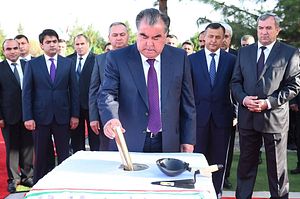Only 43 percent of the more than 4 million Tajiks part of the eligible working age population in are actually in the labor force, either employed or looking for work. The remaining 57 percent are not in the labor force, as economists put it, and less than a quarter of that portion are in school. The rest are slipped into a “neither employed nor in school” inactive category numbering more than 1.8 million. Meanwhile, the country’s unemployment statistics don’t do this reality justice, estimated at 5 percent in a recent World Bank report and at 2.3 percent in the CIA World Factbook.
The World Bank report, Tajikistan Jobs Diagnostic: Strategic Framework for Jobs, says that not only is the Tajik economic failing to create sufficient jobs for a growing workforce, but that a decade of high growth — thanks to remittance revenue — hasn’t contributed to structural transformation in the country’s domestic economy that would spark local and sustainable job growth. Rather than move into more productive economic sectors, Tajik workers “moved out of the more productive sectors, such as industry, into low-productivity services and agriculture sectors, where domestic job creation was the highest.”
The report diplomatically phrases Tajikistan’s problem like this: “The potential workforce is growing, but too many working age adults are not in the labor force; as a result, Tajikistan’s most valuable resource—its human capital—is underutilized.”
By underutilized, the report means that a significant number of working-age Tajiks (15-64) are not working and further, not even looking for work — “ and therefore, are not contributing to economic growth.”
Youth (those between the ages of 15 and 24) are acutely impacted by the lack of opportunities in the Tajik economy. “Youth who are idle, i.e. youth who are neither employed nor in school (NEET), represent 40 percent of the total, which is high by international standards.” Women, also, are at a disadvantage, with the difference in employment rates between men and women worsening from 21 percentage points to 35 percentage points between 2003 and 2013.
Why are so many possible Tajik workers not employed and not looking? There simply aren’t jobs in Tajikistan and working in Russia, which 90 percent of Tajik labor migrants do, cannot make up for a failed Tajik job market. The report says that the formal private sector is “squeezed by the large public and informal sectors” and “underdeveloped.” New firms are few and far between, and older, larger firms are plagued by inefficiencies.
The report recommends a “strategic framework for jobs” built around three pillars: promoting private sector growth; improving productivity, earnings, and access to formal employment; and connecting people to jobs. Creating the conditions to spark private sector growth is deemed a “pre-requisite” to creating job growth. Such conditions require addressing barriers to entry as well as everything from regulations to finance to “improving macroeconomic management and governance to reduce risks and uncertainty.” Each piece seems a herculean task.
Take macroeconomic policies, for example. Tajikistan faces three macroeconomic challenges: addressing external vulnerabilities, reforming budget and tax processes, and “creating fiscal space” To address all three, the World Bank report puts forth reasonable policy options which tend to follow a theme of minimizing unnecessary interventions and audits and reducing ambiguity, restrictions, and increasing transparency.
Previous reforms, the report notes, have been promising. “ Since 2008, the Government has eased barriers to new businesses by eliminating unnecessary procedures, lowering minimum capital requirements, and centralizing government functions related to registration of new businesses (creating a one-stop-shop).” But in the next paragraph the report notes that limited or inconsistent implementation of past reforms has led to a private sector hesitant to invest.
Tajikistan has made great plans. The report says that “ in recent years much attention has been given to developing high quality framework legislation,” but it seems that the application and compliance oversight of such reformed frameworks is, at best, inconsistent.
The challenges facing the country are multitudinous: “Tajikistan continues to face challenges which are associated with structural features of the country (geography), its structural transformation path (agrarian country), demographics (youth bulge), and institutional development (legacy of transition). All of these… are important constraints (as well as opportunities) to Tajikistan achieving the more, better and more inclusive job outcomes.”
The report doesn’t address politics and hardly mentions corruption, but both most certainly have also influenced the inability of Tajikistan to capitalize on a decade of relatively high growth rates to invest in its own people.

































